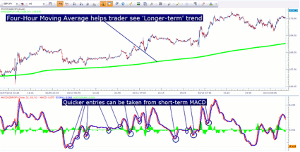The MACD can be helpful as a timing indicator to enter positions, as a trade trigger, plus it can be used in many types of strategies, says James Stanley of DailyFX.com.
Having a strong trigger in a trading strategy can be a very important component. After all, to have a bias and to blindly buy or sell to trade on that bias can be categorized as haphazard; and in some cases, that may be a bit of an understatement.
Having a trigger helps with timing the entry into a position. It won’t be perfect, but this is trading and perfection is impossible in the first place. Rather, a strong trigger is a way that traders can look to increase the probabilities of success by allowing the market to begin showing the trader what is wanted before any position is ever entered.
Let’s look at a few examples below to illustrate in more detail.
Using MACD with a Fundamental Approach
Many fundamental traders eschew technical analysis for one reason or the other. This isn’t to say that technical analysis is better or vice versa; these are just two differing ways of analyzing a market. But, the best way is often to try to include them both, and something like a MACD entry trigger can be a best friend to a fundamental trader.
Let’s say that a trader has a bias on the market. This can be any bias: Perhaps the trader expects the S&P to begin tumbling lower…or maybe the trader is expecting the Aussie to shoot to the moon on the back of a cheap dollar and stronger than expected Chinese data. Whatever the case and whatever the bias, the trader can wait to enter the position until the market appears more primed for their idea to come to fruition.
The trader can simply watch the four-hour chart to get a MACD entry signal in the direction that they are looking to trade.
The trader can even look to manage the position via MACD after the first trade is placed.
If a contrarian MACD signal shows up MACD crosses down and under the signal line while in a long position or vice versa); the trader can look to close the long position until another bullish trigger takes place.
Traders can use MACD to trigger in direction of their bias

Created with Marketscope/Trading Station II; prepared by James Stanley
Click to Enlarge
Using this type of approach can allow the fundamentals trader to get potentially higher probabilities of success since they’re waiting for the technical environment to agree with their fundamental bias before triggering into the position.
Using MACD as a Scalper/Day-Trader
Just as the fundamental-based trader can use MACD to trigger trades in the direction of their bias, scalpers and daytraders can look to do the same on very short-term charts.
Shorter-term traders can use the hourly or four-hour chart to look for trends or biases in the marketplace that may be operable for their purposes; and then can look to enter position with MACD crossovers in price movements in that direction.
Scalpers can use longer-term trend analysis and shorter term MACD entries in direction of trend

Created with Marketscope/Trading Station II; prepared by James Stanley
Click to Enlarge
The MACD trigger can be investigated on the five- or 15-minute charts to look for quick entries in the direction of slightly longer-term swings.
MACD Triggers as Part of a Broader-based Technical Strategy
Traders can also look to implement a MACD trigger in conjunction with additional technical methods of analysis.
In the four-hour trader, we looked specifically at that type of strategy.
Traders can use a longer-time frame chart, such as the daily chart to investigate trends and determine any relevant biases that may exist in the marketplace.
Once the trader has determined the direction that they want to trade in a market given the trend found on the longer-term charts, they can then go down to the shorter time frame chart to wait for a MACD signal in the direction of that trend.
Multiple time frame analysis can bring enormous benefit to the trader.
The longer time frame provides the “bigger picture” view of any biases or trends that may exist in the marketplace; and the MACD trigger on the shorter time frame can allow the trader to focus on high-probability setups in which the longer-term bias may be coming back into the market.
By James Stanley, Trading Instructor, DailyFX.com





















